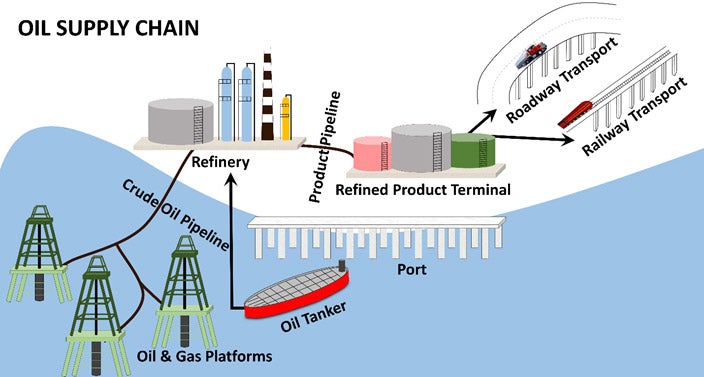Fragility and Resilience Enhancement of Energy Infrastructure
Energy infrastructure is a key target of the fragility, risk and resilience modeling efforts in the Padgett Research Group. Our work ranges from experimental testing, to high fidelity numerical modeling, to probabilistic risk assessment under multiple hazards. Fundamental understanding of behavior under such loads as multi-hazard coastal storm events is offered at the structural system level along with probabilistic frameworks to evaluate regional portfolio and supply chain network resilience.
A) Coastal Risks of Petrochemical Facilities and Tank Farms
Description: Due to their location in coastal regions, petrochemical infrastructure are exposed to natural hazard such as flooding, tropical storms, and hurricanes. Petrochemical infrastructure suffered damage resulting in the release or spill of hazardous chemicals during almost every major storm events in the United States. Thus, the Padgett Research Group is actively developing tools to assess the vulnerability and the risks posed by petrochemical facilities during storm and hurricane events and enhance the resilience of these infrastructure. The work performed by the Padgett Research Group specifically focuses on aboveground storage tanks (ASTs) as they are one of the most vulnerable petrochemical infrastructure during storm events, and are historically responsible for some of the largest chemical spills during storms.
Figures:
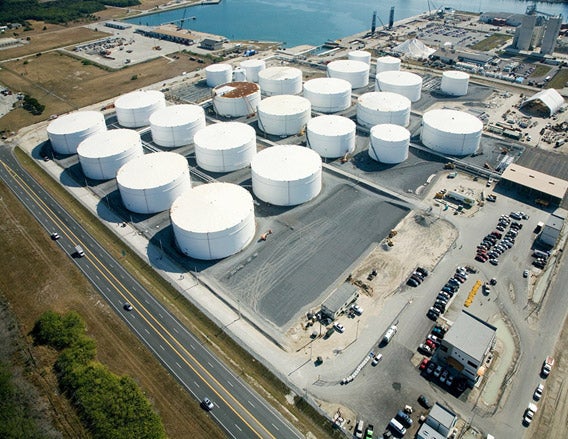
A1) Numerical modeling of aboveground storage tanks and experimental testing
Description: In order to assess the structural vulnerability of petrochemical infrastructure during storm events, the Padgett Research Group heavily relies on the finite element modeling of these structures. Finite elements models were developed to assess hydrodynamic loads on aboveground storage tanks (ASTs), to investigate the buckling behavior of ASTs subjected to surge, wave, and wind loads, to evaluate the potential for sliding or flotation of ASTs, and to determine the potential damage from water-driven debris impacts. The finite element models developed by the Padgett Research Group are usually well validated against experimental results available in the literature. In some cases, Padgett Research Group also collaborates with other universities in the United States, via the NSF-supported Natural Hazards Engineering Research Infrastructure, to develop and perform our own experiments as shown in the figure below.
Figures:
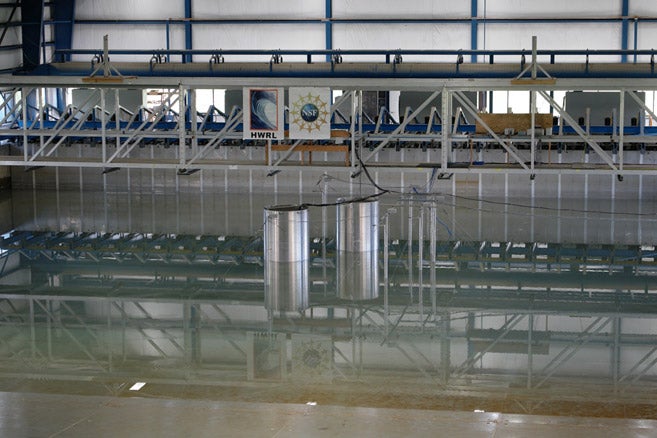
A2) Fragility assessment of aboveground storage tanks during multi-hazard storm events
Description: Using finite element models and statistical sampling methods, such as Latin Hypercube Sampling, the Padgett Research Group developed a series of fragility models to assess the structural vulnerability of aboveground storage tanks (ASTs) during severe storm events. To facilitate their usage across regional portfolio of ASTs, all fragility modeled are parametrized on AST geometry, material properties, internal liquid properties, and load conditions. Fragility models are available or a subject of ongoing research for ASTs subjected to wind, surge, wave, rainfall, and debris impact loads, as well as for combinations of these different loads.
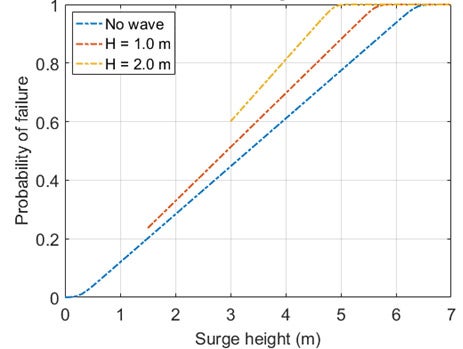
A3) Evaluation of mitigation strategies for aboveground storage tanks
Description: The fragility models derived by the Padgett Research Group for aboveground storage tanks (ASTs) are employed to evaluate the effectiveness and validity of various mitigation measures in order to reduce the risks posed by ASTs during storm events. The different measures investigated range from procedural strategies such as filling ASTs with product or sea water before a storm, structural details such as anchoring ASTs to the ground or changing their stiffness, and hazard protection systems such as building levees or berms to protect ASTs from surge effects. Padgett Research Group also developed tools to compare mitigation strategies in terms of reduction of spill risk and benefit-cost ratio as well as tools to optimally select mitigation strategies given a cost or risk objective.
Figures:
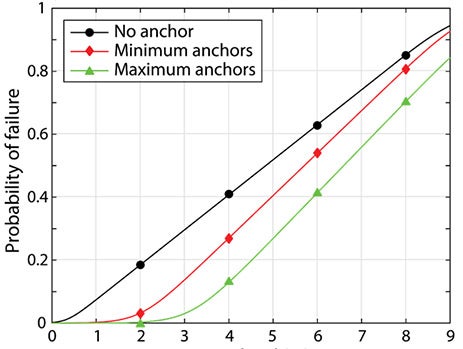
A4) Large-scale risk assessment of industrial regions
Description: The different fragility models derived by the Padgett Research Group for aboveground storage tanks are used to perform large-scale regional risk assessments of industrial corridors or petrochemical complex. Parametrized fragility models can easily provide the probability of failure for all storage tanks in an industrial area. In turn, this allows to obtain probability of failure maps to determine the most vulnerable locations during storm or hurricane events. Such an example is shown below for the Houston Ship Channel, the largest petrochemical complex in the United States, and a 500-year storm event. The fragility models can also be used to estimate potential spill volumes in industrial area as well as to determine how such spill risk is correlated with social vulnerability of nearby communities. Our regional spill risk assessments are also used by environmental engineers at Rice University to develop water and air pollution models.
Figures:
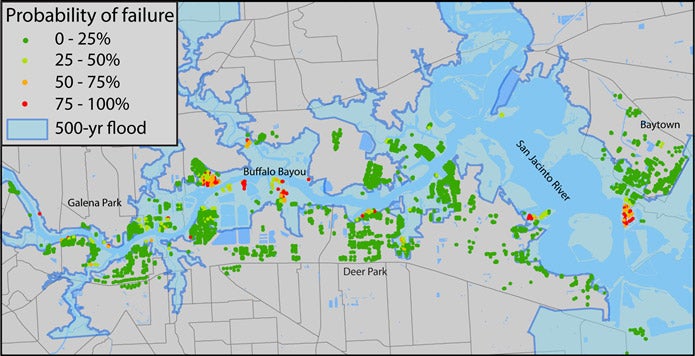
B) Multi-Threat Modeling for Nuclear Waste Storage Tanks
Description: In the absence of a long-term storage option, dry cask structures are used for intermediate storage of spent nuclear fuel. Given the potentially significant consequences of damage to these structures, performance assessment of dry casks under extreme events, such as earthquakes, is critical to inform risk assessment and mitigation activities. Research in Padgett's group investigates the probabilistic performance of vertical concrete dry casks with an emphasis on the behavior under joint aging and seismic threats. Experimentally-validated finite element models are employed for the analysis of concrete dry casks subjected to seismic and impact loads. Machine learning techniques are trained on the data provided by the finite element analyses, and parametric probabilistic demand models are developed for key responses such as seismically-induced motions and maximum canister strains in impact events. These probabilistic models can support fragility analysis, sensitivity analysis and risk assessment of a broad range of concrete dry casks located in seismic zones. The risk evaluation results aid stakeholders in assessing existing risks to dry cask storage systems and understanding how these risks evolve in time when managing spent nuclear fuel.
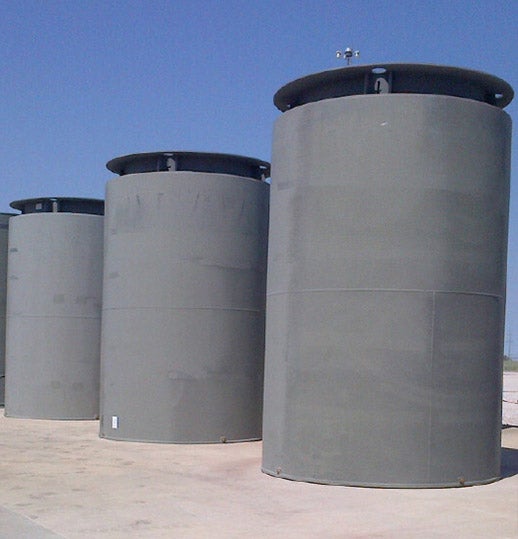
C) Coastal Risk to Oil and Gas Supply Chain
Description: Some of the largest oil and gas facilities in the world are located in coastal regions. Considering the socio-economic and environmental risks associated with hurricane and storm impacts to these facilities, work in the Padgett Research Group develops frameworks for risk assessment of oil and gas supply chains and their constituent infrastructure. Ongoing and future work explores the vulnerability of different components such as the platforms, pipelines, refineries, and processing plants, and probabilistic models depicting the performance of different components in extreme events are developed. Tools such as Bayesian Networks are applied for systems analysis and updating of supply chain models from an infrastructure damage, operation and commodity flow perspective.
